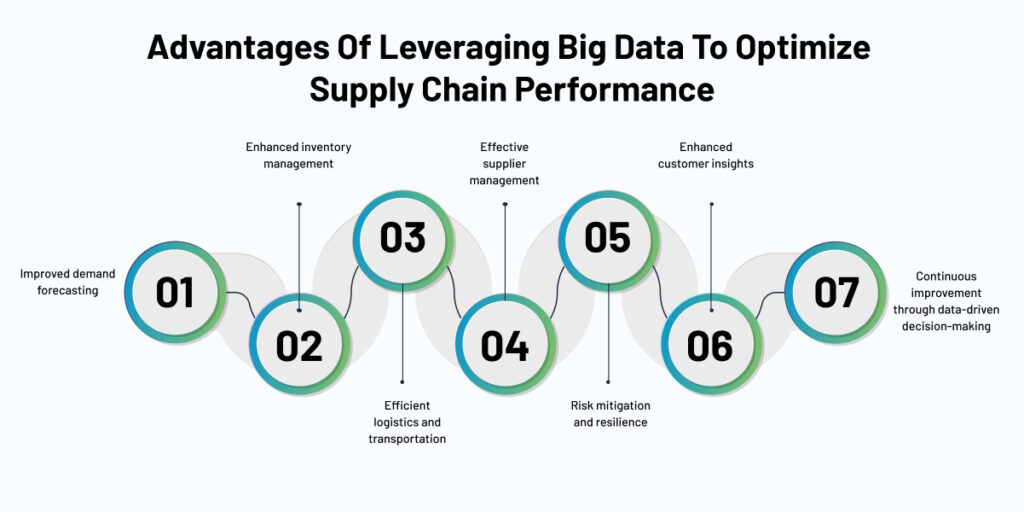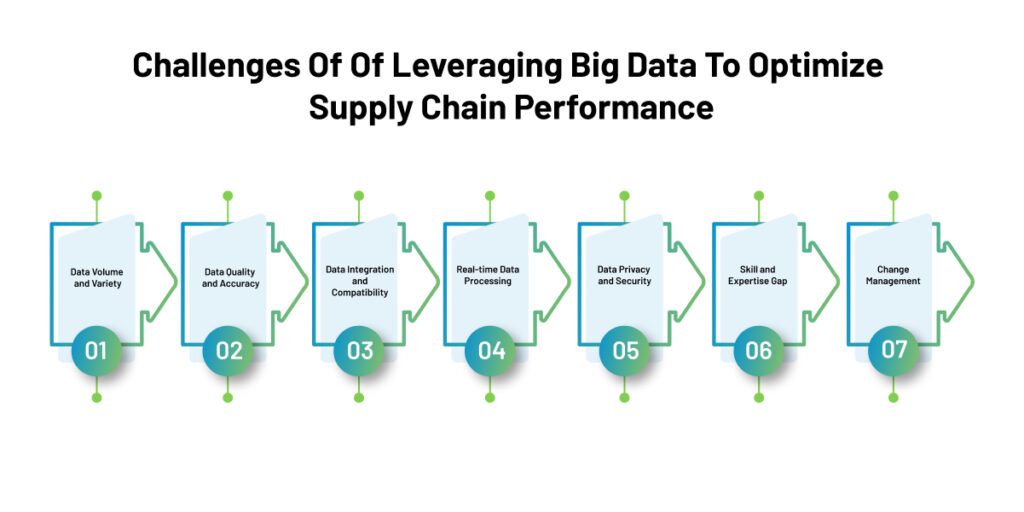In the fast-paced world of logistics, where every minute counts and customer satisfaction is paramount, businesses are turning to data analytics as a powerful tool to gain a competitive edge. The ability to extract meaningful insights from vast amounts of data has revolutionized the logistics industry, enabling companies to optimize their supply chain performance like never before. This transformative approach, fueled by the concept of Big Data, has opened up new avenues for improving efficiency, reducing costs, and delivering exceptional customer service.
In this blog, we will explore the role of data analytics in logistics and how utilizing Big Data can drive significant improvements in supply chain management. We will explore how data analytics enables businesses to streamline operations, enhance decision-making, and achieve optimal supply chain performance.
From demand forecasting to route optimization, warehouse management, risk mitigation, and gaining valuable customer insights, we will uncover the invaluable applications of data analytics throughout the logistics ecosystem. By harnessing the power of Big Data and implementing robust data analytics strategies, businesses can unlock hidden patterns, identify optimization opportunities, and make data-driven decisions that can shape the future of their logistics operations.
Logistics is the backbone of modern-day businesses, keeping operations running efficiently and ensuring the timely delivery of goods and products to their intended destinations. The supply chain is one key factor that plays a key role in the smooth functioning of logistics. So before we get to the intricacies of data analytics, let’s understand the importance of supply chain optimization in logistics.
Importance of Supply Chain Optimization in Logistics
Supply chain optimization is crucial in logistics, where efficiency, cost-effectiveness, and timely delivery are paramount. It involves the strategic management and coordination of various interconnected activities, including procurement, production, inventory management, transportation, and distribution. By optimizing the supply chain, businesses can achieve significant benefits and gain a competitive advantage in the marketplace.
- Efficiency: Optimized supply chains minimize delays, reduce idle time, and optimize resource allocation for smooth operations.
- Cost Reduction: Optimization helps eliminate unnecessary inventory, optimize transportation routes, and streamline warehousing to reduce costs.
- Customer Satisfaction: Well-optimized supply chains enable faster and more accurate deliveries, improving customer satisfaction.
- Demand Responsiveness: Optimization allows quick adjustments to inventory, production, and distribution strategies to meet changing customer demands.
- Risk Mitigation: Optimization helps mitigate risks from disruptions, ensuring business continuity and minimizing the impact of unforeseen events.
- Collaboration and Visibility: Optimization promotes collaboration and enhances visibility across the supply chain for better decision-making and efficiency.
- Continuous Improvement: Optimization involves continuous evaluation and improvement to adapt to market dynamics and drive innovation.
- Sustainability: Optimized supply chains consider sustainability factors, reducing emissions and waste and adopting eco-friendly practices.
Big Data in Logistics: An Overview
Big Data refers to extremely large and complex datasets that cannot be effectively managed, processed, or analyzed using traditional data processing techniques. It is characterized by the “three V’s”: Volume, Velocity, and Variety.
- Volume: Big Data involves massive amounts of information generated from various sources such as sensors, social media, transactions, etc. The sheer volume of data makes storing and processing using conventional methods challenging.
- Velocity: Big Data is generated and updated in real-time or near real-time. The speed at which data is produced requires efficient processing and analysis methods to derive meaningful insights.
- Variety: Big Data encompasses diverse data types, including structured data (e.g., databases), semi-structured data (e.g., XML), and unstructured data (e.g., text, images, videos). Handling this variety demands flexible data processing techniques.
Primarily, the logistics industry deals with a vast amount of data at each stage of the supply chain. Big Data analytics can provide valuable insights and enable logistics companies to make data-driven decisions, optimize operations, and enhance efficiency.
Here are some key areas where Big Data is relevant in logistics:
- Demand Forecasting: By analyzing historical data, market trends, and external factors, logistics companies can accurately predict demand patterns and adjust their inventory levels and transportation resources accordingly. This helps minimize stockouts, reduce excess inventory, and optimize supply chain costs.
- Route Optimization: Big Data analytics can optimize route planning and scheduling by considering real-time traffic conditions, weather forecasts, and historical data. This enables logistics companies to choose the most efficient routes, reduce fuel consumption, improve delivery times, and enhance customer satisfaction.
- Warehouse Management: Big Data can improve warehouse operations by analyzing data on product demand, inventory levels, and storage capacities. This allows logistics companies to optimize inventory placement, reduce picking errors, streamline order fulfillment, and enhance warehouse efficiency.
- Risk Management: Big Data analytics can help identify potential risks in the supply chain, such as supplier disruptions, natural disasters, or geopolitical events. Logistics companies can proactively mitigate risks, develop contingency plans, and ensure business continuity by analyzing relevant data.
- Customer Insights: Analyzing customer data, including purchase history, feedback, and social media interactions, can provide valuable insights into customer preferences and behaviors. This information can be leveraged to personalize services, improve customer satisfaction, and drive customer loyalty.
Big Data has emerged as a powerful tool in the logistics industry. By harnessing the vast amount of data available, logistics companies can optimize their operations, improve decision-making, and gain a competitive edge. The ability to extract meaningful insights from Big Data allows them to enhance efficiency, reduce costs, and deliver better customer experiences.
Also, Read – How to Turn Data into Insights – Role of Big Data in Manufacturing
Advantages of Leveraging Big Data to Optimize Supply Chain Performance
Leveraging big data to optimize supply chain performance offers several advantages that can greatly enhance the efficiency and effectiveness of supply chain operations. Here are some key advantages:

Improved demand forecasting: Big data analytics can help identify patterns, trends, and correlations within large volumes of data, enabling more accurate demand forecasting. This leads to better inventory management, reduced stockouts, and improved customer satisfaction.
Enhanced inventory management: Big data analytics can provide real-time visibility into inventory levels, locations, and movement throughout the supply chain. This enables businesses to optimize inventory levels, minimize carrying costs, and prevent excess or obsolete inventory.
Efficient logistics and transportation: Big data analytics can optimize transportation routes, modes, and carrier selection based on factors such as cost, capacity, and delivery time. This can result in reduced transportation costs, improved delivery performance, and better overall logistics efficiency.
Effective supplier management: Big data analytics can assess supplier performance based on various metrics such as quality, delivery time, and pricing. This helps identify reliable and high-performing suppliers, leading to better supplier selection, improved relationships, and reduced supply chain risks.
Risk mitigation and resilience: Big data analytics can monitor and analyze various data sources, such as weather data, economic indicators, and geopolitical factors, to identify potential risks and disruptions in the supply chain. This enables proactive risk management and the development of contingency plans to mitigate the impact of unforeseen events.
Enhanced customer insights: Big data analytics can analyze customer data, including purchasing behavior, preferences, and feedback, to gain valuable insights. This enables businesses to personalize their offerings, improve customer satisfaction, and tailor their supply chain strategies accordingly.
Continuous improvement through data-driven decision-making: Leveraging big data allows for data-driven decision-making and continuous improvement throughout the supply chain. By analyzing and interpreting vast amounts of data, businesses can identify bottlenecks, inefficiencies, and opportunities for optimization, leading to ongoing process improvements.
Leveraging big data to optimize supply chain performance can be highly beneficial, but it also presents several challenges. And what are these challenges? Let’s have a look.
Challenges of Leveraging Big Data to Optimize Supply Chain Performance
Here are some of the key challenges associated with using big data in supply chain optimization:

Data Volume and Variety: Big data refers to large and complex datasets that come from various sources, including internal systems, external partners, sensors, social media, and more. Managing and processing such vast amounts of data from diverse sources can be challenging, requiring robust data storage and analytics infrastructure.
Data Quality and Accuracy: The accuracy and quality of the data used for analysis directly impact the effectiveness of supply chain optimization efforts. Data inconsistencies, errors, and missing values can lead to incorrect insights and suboptimal decisions. Ensuring data accuracy and quality can be a significant challenge, especially when dealing with data from multiple sources.
Data Integration and Compatibility: Integrating data from various systems and sources within the supply chain can be complex. Different data formats, standards, and systems used by different stakeholders may pose compatibility issues. It requires developing data integration strategies, using standardized formats, and establishing data-sharing agreements with partners.
Real-time Data Processing: Supply chains operate in a dynamic environment where real-time data is crucial for effective decision-making. Processing and analyzing big data in real time to provide timely insights can be challenging, as it requires powerful computing capabilities and efficient algorithms. Delays or inefficiencies in data processing can limit the agility and responsiveness of the supply chain.
Data Privacy and Security: Handling big data involves dealing with sensitive information related to customers, suppliers, operations, and financials. Ensuring data privacy and security is crucial to protect against unauthorized access, data breaches, and misuse. Complying with privacy regulations, implementing robust security measures, and establishing data governance frameworks are essential but challenging tasks.
Skill and Expertise Gap: Leveraging big data requires specialized skills and expertise in data analytics, statistical modeling, machine learning, and supply chain domain knowledge. Organizations need to invest in training and hiring data scientists, analysts, and supply chain professionals who can effectively leverage big data to drive optimization. However, the scarcity of skilled professionals can pose a challenge.
Change Management: Implementing big data analytics for supply chain optimization often requires significant organizational changes and process reengineering. Adopting new technologies, integrating data-driven decision-making into existing workflows, and gaining buy-in from stakeholders can be challenging. Change management strategies and effective communication are necessary to overcome resistance and ensure successful adoption.
Despite these challenges, the potential benefits of leveraging big data in supply chain optimization, such as improved forecasting accuracy, enhanced inventory management, streamlined logistics, and better demand planning, make it a worthwhile pursuit for organizations seeking to gain a competitive edge in today’s data-driven business landscape.
Also, Read – Top 9 Data and Analytics Trends for 2023 and Beyond
Final Words
In conclusion, data analytics has emerged as a powerful tool in the logistics industry, enabling organizations to optimize their supply chain performance and drive operational efficiency. Leveraging big data offers immense potential for businesses to make data-driven decisions, enhance visibility, and gain a competitive edge in a rapidly evolving marketplace.
However, harnessing the full potential of big data in supply chain optimization comes with its own set of challenges. Addressing issues related to data volume, variety, quality, integration, and security requires careful planning and investment in robust infrastructure and skilled resources. Additionally, organizations must navigate through the complexities of real-time data processing and overcome resistance to change.
To overcome these challenges and effectively leverage big data for supply chain optimization, businesses can seek the assistance of business transformation consultants. These consultants bring expertise in data analytics, supply chain management, and change management, enabling organizations to navigate the complexities and ensure the successful adoption of data-driven strategies.
Ultimately, the integration of data analytics and big data in logistics has the potential to revolutionize the industry, enabling organizations to streamline operations, reduce costs, enhance customer satisfaction, and unlock new opportunities for growth. By embracing this transformative approach and leveraging the expertise of business transformation consultants, businesses can stay ahead of the curve and drive success in today’s data-centric world.




